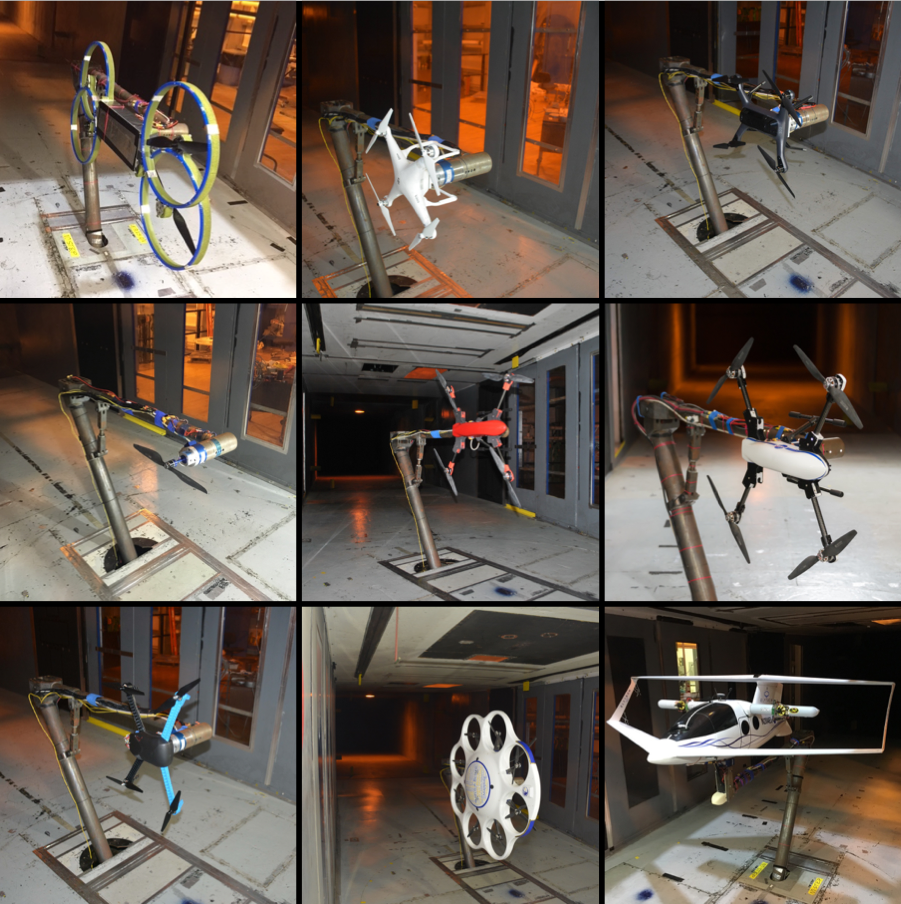Multicopter UAS Performance Test

NASA has now conducted two wind tunnel test programs with the goal of measuring the performance of several different multicopter Unmanned Aerial Systems (UAS) vehicles. The tests were carried out in the US Army's 7– by 10–ft wind tunnel at NASA Ames Research Center. The first test, in late 2015, was jointly supported by three NASA Aeronautics programs: DELIVER (Design Environment for Novel Vertical Lift), under CAS (Convergent Aeronautics Solutions), RVLT (Revolutionary Vertical Lift Technology), and UTM (UAS Traffic Management). The second test, in early 2017, was again supported by DELIVER and RVLT, with the addition of the US Army Advanced Design Office.
The key data collected during the Multicopter UAS tests included forces and moments and electrical power as a function of aircraft attitude, rotor RPM and wind speed. Forces and moments were measured using a low–cost 6–axis load cell. Typically a sting balance would be used for this type of application due to its superior accuracy; however, prior to the 2015 test, there was a high degree of uncertainty in the load predictions. To avoid the risk of damage to an expensive sting balance, the lower–cost load cell was selected. Despite the slightly reduced accuracy, the quality of the data was very good, with smooth trends and repeatable data points.
The models were mounted to the load cell using an interchangeable interface plate that allowed for fast model changes. All but one of the models were mounted at a 90–degree roll angle to a rigid sting so that the wind tunnel turntable could be used to control pitch, and allowed pitch changes without bringing down the tunnel speed. Yaw was adjusted manually with an interface tube between the load cell and the sting. Speeds up to 80 ft/s (55 mph) were tested, but the majority of testing was done at 20 and 40 ft/s. Pitch was varied between –40 and +40 deg, and yaw ranged from 0 to 90 deg.
In all, five vehicles were tested during the 2015 test program, including four quadcopters–3DR SOLO, 3DR Iris+, DJI Phantom 3, Straight Up Imaging Endurance–and a Drone America DAx8 octocopter. The vehicle maximum weights range from approximately 3 lb to 20 lb. The data acquired from the 2015 test are publicly available, and have already been put to use by multiple organizations for validation of aerodynamic prediction tools.
With the success of the first multicopter UAS test came additional research questions that could not be addressed during the 2015 tunnel entry. The goals of the 2017 test included addressing some of these issues. In particular, vibrations, blade deflections, and rotor–rotor interference were investigated.
-
The additional measurements are summarized here:
- – Vibrations – measured with the load cell mounted under the vehicles
- – Blade deflections – measured with a stereophotogrammetry system
- – Rotor–rotor interference – measured indirectly by installing only one or two rotors at a time on the vehicle in the tunnel
The vehicles that were tested included two of those from the 2015 test – the DJI Phantom 3 and the Straight Up Imaging Endurance. In addition, an overlapped quadrotor model and a tiltwing model were tested. Several isolated rotors were also included.
In all, the multicopter UAS tests have provided a large collection of data, which is being used to improve prediction tools for these types of aircraft. Ultimately, these improvements in predictive tools will lead to better UAS designs, allowing expanded performance capabilities.
Recent Publications:
- Russell, C., Willink, G., Theodore, C., Jung, J., and Glasner, B., "Wind Tunnel and Hover Performance Test Results for Multicopter UAS Vehicles," NASA/TM–2018–219758, February 2018.
- Russell, C., Sekula, M., and Theodore, C., "Incorporating Test Data for Small UAS at the Conceptual Design Level," AHS Technical Conference on Aeromechanics Design for Transformative Vertical Flight, San Francisco, CA, January 16–18, 2018.
- Russell, C. and Sekula, M., "Comprehensive Analysis Modeling of Small–Scale UAS Rotors," AHS 73rd Annual Forum, Fort Worth, TX, May 9–11, 2017.
- Russell, C., Willink, G., Jung, J., and Glasner, B., "Wind Tunnel and Hover Performance Test Results for Multicopter UAS Vehicles," AHS 72nd Annual Forum, West Palm Beach, FL, May 16–19, 2016.
Point of Contact
Carl Russell
NASA Ames Research Center
Moffett Field CA 94035-1000